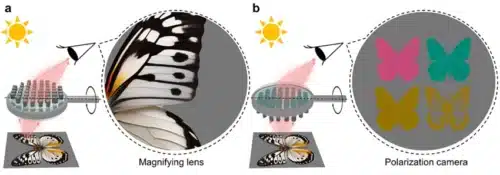Researchers at KAIST have developed an advanced Janus metasurface, offering groundbreaking control over light transmission, with significant implications for secure data transmission.

The Janus metasurface, developed by a team led by Jonghwa Shin, prof. , department of materials science and engineering, Korea Advanced Institute of Science and Technology (KAIST) is designed to precisely manage asymmetric light transmission. This new technology overcomes the limitations of traditional metasurfaces by regulating light’s intensity, phase, and polarization based on its direction of incidence.
The Janus metasurface is named after the Roman god Janus, known for his two faces, symbolizing its dual function. Depending on the direction of the incoming light, the metasurface can perform two distinct optical tasks. For instance, it operates as a polarized camera in one direction and as a magnifying lens in another. This dual functionality opens up new possibilities for optical systems that can switch between different modes based on the direction of light.
This breakthrough makes the technology particularly valuable for industries that rely on secure data transmission, such as telecommunications, quantum computing, and defense sectors. The ability to precisely control light and its encryption potential offers enhanced security in communication systems. Companies developing next-generation augmented reality (AR), holographic displays, and LiDAR systems for autonomous vehicles are likely to benefit from this innovation, as it paves the way for more compact and lightweight optical devices.
The researchers developed vector holograms that work in both directions, demonstrating the full potential of asymmetric light transmission control. This capability addresses a longstanding challenge in the field, as previous metasurfaces lacked the ability to handle such precise control over light properties.
Additionally, the KAIST team introduced an innovative optical encryption method. This system enhances security by allowing information to be decoded only under specific light conditions, significantly increasing the protection of transmitted data. “We plan to continue developing optical devices that can be applied to various fields, such as augmented reality (AR), holographic displays, and LiDAR systems for autonomous vehicles, utilizing the full potential of metasurface technology,” said Professor Shin.
The ultra-thin structure of the metasurface also offers practical benefits, such as reducing the size and weight of traditional optical devices. This makes it particularly suitable for next-generation electronics, including quantum communication systems and secure data transmission solutions.
This research will be contributing to the advancement of metasurface technology in optics and security applications.





